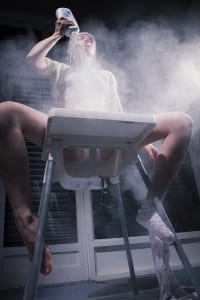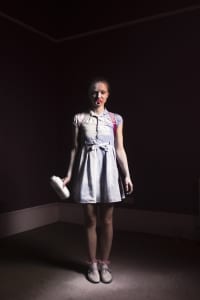Katy Dye is absolutely unflinching in her one woman exposition of the tandem infantilisation and sexualisation of women in contemporary media and wider society, creating a visceral experience that leaves audiences uncomfortable, haunted by the distressing truth that lurks all around us.
 The only set piece throughout is an exceedingly sturdy high chair which Dye utilises as her main prop in much of her dancing and movement, forming a kind of high chair acrobatics: spinning it, lifting it high, sprawling across it and sensually lounging on it. It is unclear in these moments of physical theatre whether she is attempting to stuff herself, a grown woman of 27, into the baby chair, and is thus complicit in her own infantilisation or if she is wrestling with it, trying desperately though it appears futile. As the performance goes on, it seems she is indeed depicting both of these contradictions simultaneously, thus epitomising the contradiction and struggle of being a feminist in a society that bombards women with images of the ‘ideal’ woman.
The only set piece throughout is an exceedingly sturdy high chair which Dye utilises as her main prop in much of her dancing and movement, forming a kind of high chair acrobatics: spinning it, lifting it high, sprawling across it and sensually lounging on it. It is unclear in these moments of physical theatre whether she is attempting to stuff herself, a grown woman of 27, into the baby chair, and is thus complicit in her own infantilisation or if she is wrestling with it, trying desperately though it appears futile. As the performance goes on, it seems she is indeed depicting both of these contradictions simultaneously, thus epitomising the contradiction and struggle of being a feminist in a society that bombards women with images of the ‘ideal’ woman.
The performance begins with Dye perched upon the high chair wailing and screaming into a microphone like a baby immediately setting the audience’s teeth on edge. She goes on to speak like a child – high pitched and grating – while discussing how undeveloped body parts, such as a flat stomach, thin thighs and a flat chest, are sexualised views of the ‘ideal’. Dye, from the very opening of the performance, goes about exposing the damaging effect of such toxic and distressing beauty standards; it is harrowing and insightful. A notable part of the experience is the disconcerting use of audience participation that is effective in its ability to bring apprehensive male audience members into the performance. Dye asks them direct and challenging questions with an unwavering, deadpan delivery. In one occasion, she asks them to be complicit in her infantilisation by carrying her across the stage like a baby, stroking her hair and putting a plaster on her knee.
Dye’s characterisation throughout the performance is both impressive and distressing as she constantly fluctuates between sensuality, attempting to seduce the audience, and childish characterisations thus demonstrating their troubling performative overlap. This is epitomised in perhaps the most memorable scene of the performance in which Dye imitates the dance routine of Britney Spears’ iconic music video ‘Hit Me Baby One More Time’ whilst wearing an uncomfortably small, tight school uniform in reference to one of the most prominent examples of infantilisation and sexualisation in the media. In the middle of the routine she changes into a slightly longer skirt and school jumper (complete with school crest) which genuinely makes her look 14 years; she embodies a typical flailing, grumpy teenager lamenting that no one “fancies” her. This marks a shift from a sexual fantasy to reality thus exposing the damaging impact upon real, young girls.

Overall, Dye has created a poignant performance exposition of this troubling patriarchal practice. In my opinion, however, she could have gone deeper; I would have liked to have seen more parodies of popular media as the examples used were almost more effective than her symbolic movement. Ultimately, I am so glad she is addressing this issue and hope she can spread her message to as many as possible in order to tackle and dismantle this disturbing process.

